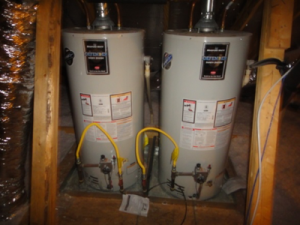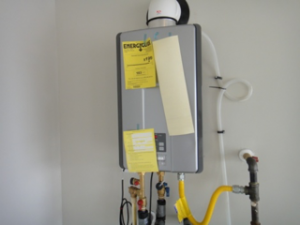12 May Traditional vs. Tankless Water Heaters
 Need a new water heater? To start your search, you need to decide between the two main water heater types: traditional water heaters and tankless water heaters.
Need a new water heater? To start your search, you need to decide between the two main water heater types: traditional water heaters and tankless water heaters.
So, which one is better?
Well, that’s for you to decide. Like most purchases, there are trade-offs. To make an educated decision, we’ve created this buyer’s guide to help you understand the differences between tankless and traditional water heaters and learn the pros and cons of each.
What’s the Difference between a Traditional and Tankless Water Heater?
A traditional water heater stores and preheats 30–50 gallons of water in a tank. That preheated water is used whenever someone showers, does the laundry, or washes dishes. The tank then refills to be reheated once again.
A tankless water heater uses a heat source (electric or gas) to warm up cool water on-demand whenever you need it rather than storing hot water in a tank.
Pros and Cons of Traditional Water Heaters
Pros:
-

Traditional tank gas water heaters
Lower initial cost. A traditional water heater installation can be half as much as a tankless water heater.
- Easy and inexpensive to replace. Less installation complications means that there’s less that can go wrong.
Cons:
- Higher utility bill. They heat and reheat water at a pre-set temperature regardless of your water needs. This increases your utility bill—especially during the winter.
- Bigger and harder to place. They occupy more room and can’t be placed outside.
- Can run out of hot water. Ever been the last in your family to get the shower? It’s a chilling experience. This problem can be avoided by purchasing a larger tank (although that will be more in energy costs, as well).
- Shorter life (lasts 10–15 years). This means there’s more turnover and, therefore, you have to buy them twice as often as a tankless water heater.
Pros and Cons of Tankless Water Heaters
Pros:
-

Tankless water heater
Saves money in the long run. According to Energy.gov, “For homes that use 41 gallons or less of hot water daily, demand (or tankless) water heaters can be 24%–34% more energy efficient than conventional storage tank water heaters.”
- Doesn’t take up much space. They are small and can be installed in more places—even outside on a wall.
- Lives longer (lasts 20+ years). Almost double a traditional water heater’s life.
- Delivers hot water on demand. Provides two to three gallons of hot water per minute on demand.
Cons:
- Higher initial cost. Costs $2800 to $4500 to get installed (depends on the model and who you get it from).
- Retrofitting adds to upfront cost. Replacing a traditional water heater with a tankless system is more complicated, so that increases the installation cost even further.
Which Water Heater Should I Choose?
Pick the water heater that best fits your water usage, lifestyle situation, and budget.
According to Energy.gov, an Energy Star tankless water heater can save you about $100 annually.
So if you can handle the high initial costs, you can save more money in the long run by switching to tankless. Tankless can also be a good choice for large families because you have more people consistently using more hot water.
However, a traditional water heater may make more sense if you are on a limited income and need a quick replacement.
Please feel free to contact us should you have any questions regarding the operation or maintenance of your home. Give us a call today at 832-573-0771. Thanks for visiting!


